► The best small premium SUV
► Three posh rivals battle it out
► Evoque 2.0 vs Macan and Q3
Range Rover’s reborn Evoque faces the similar-looking but subtly upgraded Porsche Macan and Audi Q3 in our second-generation posh crossover face-off.
Keep scrolling for our best small SUV group test or check out these reviews:
Range Rover Evoque: baby’s back on the catwalk
The new Range Rover Evoque looks so much like the old one, it’s easy to overlook the fact that this isn’t a facelift, but actually an all-new model. You might skip past the fact it’s on JLR’s new Premium Transverse Architecture, that it introduces new mild hybrid drivetrains, has much improved infotainment and shares only door hinges with the outgoing car. But why rock the boat with an entirely different look when the last Evoque stands as the fastest-selling Land Rover in history, with around 800,000 sales since 2011? You wouldn’t.
So Evoque Mk2 sits within an almost identical footprint, and carefully evolves the design of its successful predecessor while borrowing tricks from the one-size-up Velar, with its smooth, pared-back lines. There are coppery accents on this Nolita Grey First Edition (and on R-Dynamic models) to strengthen the link, but it’s the addition of Velar-style flush door handles that most obviously indicates this is actually an all-new Evoque. They slide out when you plip the car unlocked, but it’s not the most convincing handshake – while you can grip the robust Velar’s with confidence, the Evoque’s are a little wobbly, a little looser to that initial touch. Not a great start for this £50k machine.
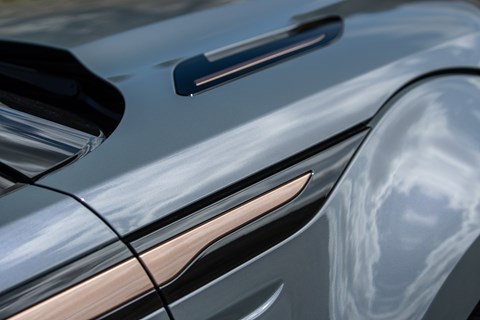
When you actually open that door, things take a turn for the better. There’s much more of a sense of occasion as you enter here than our Giant Test rivals, the Porsche Macan and Audi Q3. The light dashboard material of our test car certainly helps, as does the central touchscreen’s rise to attention upon start-up, and the muscular contours of seats that provide back support you never even realised you needed, particularly at shoulder height. As with the Velar, the Evoque can also be upholstered in animal-free materials, with the Kvadrat wool-blend textile giving a smooth alcantara-like feel.
The closer you look the more you see about the interior of the second-generation Evoque that has been refined, modernised and streamlined, with the Velar influence evident almost everywhere. It’s a mostly successful update. The centre console, for example, is now button-less, courtesy of the lower of two touchscreens managing climate control, seat heating and off-road functions, plus a shortcut menu for media interfaces. At first, haphazard prods at the screen don’t always result in the desired response, but soon it becomes second nature to use the twin click-wheels. Want to swap drive modes? That needs just a simple twist. Want your seat warmed? That’s a push away.
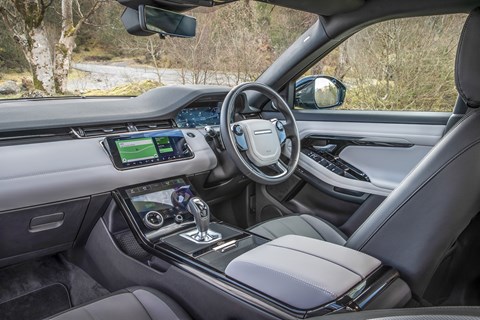
Bum toasty, we get moving. You’re struck first by excellent refinement. This is a baby SUV that glides down the road almost as silently as a full-size Range Rover. Leave it in Comfort and the P250 petrol engine quickly settles into ninth gear, but sounds more like it’s fallen down a well. It’s eerily quiet in here at a cruise, far more so than the Q3 and Macan on test, the refinement complemented by well-tuned adaptive dampers (spring and damping rates are generally softer than before) offsetting large 20-inch wheels. You can’t get an Evoque with air springs, but so supple is the ride that you never covet them.
The Evoque is more laid-back cruiser than B-road hero, even if it does a passable impression of the latter. Land Rover says increased refinement was the primary objective – but, as our test miles soon reveal, the downside of that shift of focus is that a little of the previous car’s high-rise-hot-hatch vim has gone. That said, the Ingenium turbo petrol has a more tuneful bark than either Porsche or Audi when you wake it up, feels equally punchy, and JLR’s juicy steering heft is reassuring. Setting the transmission to S also does a solid job of shifting gears snappily.
But with nine ratios to play with, keeping the engine on the boil between fourth and fifth gear is like juggling a hot potato. And there’s no disguising the Evoque’s height nor its 1818kg bulk – around 30kg more than before – when it comes to dynamics. In the wide-open spaces of North Wales the Evoque wants to play, but it’s a little like the tubby kid on the football team, its enthusiasm hamstrung by physics. There’s noticeable bodyroll through sharper turns, even in Dynamic mode, and the brakes lack strength, particularly against the Q3’s. Oddly, the steering rack gives the impression the tension comes from a series of rubber bands that relax when you add more lock. It’s still enjoyable to drive, though: you’ll have far more laughs at the wheel of Halewood’s finest than you will in the aloof tax-accountant from Ingolstadt.
Shame the P250 is so thirsty; Land Rover only claims 28.5mpg to 30.4mpg under new WLTP rules, despite a 48-volt mild-hybrid system (and therefore more efficient start/stop technology). Today we’ll see an mpg figure in the high teens…
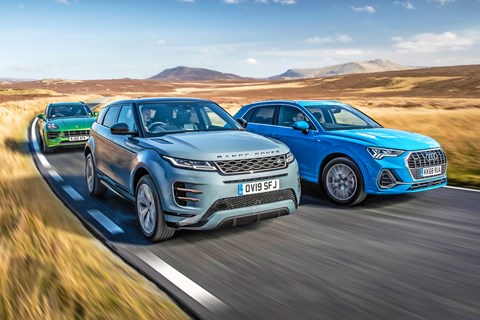
Elsewhere in the Evoque, 21st century technology’s been implemented more successfully. You can also spec a wealth of clever new toys, including our car’s optional ClearSight rear-view mirror. It can function like a normal mirror, but with a prod of a button beneath it will switch to a screen that’s linked to a HD camera housed in the roof antenna. Useful given the Evoque’s porthole-like rear visibility, and particularly so if you’re transporting a new wardrobe home or helping your university student sprog move into new halls – you can completely block the rear window and still see perfectly.
Clever cameras mounted up front (again, optional) project a ‘see-through’ image of the front of the car onto the upper infotainment screen – it allows you to see exactly where the front wheels are, helping navigate tricky terrain, urban or rural. That’s on top of a standard all-wheel-drive system, plus multiple off-road technologies.
This isn’t a perfect interior, though. Niggles and rough edges bring to mind those glossy, ultra-modern kitchens at DIY stores: all of the glitz you crave but with appliances and finish from the lowest bidder. The cupholders now have a plastic cover but it’s hollow, difficult to slot back in place and there’s nowhere to put it if you actually want to use the cupholders. And the clean, admittedly very pretty steering wheel buttons at thumb height require a fierce prod, the touch-sensitive screens can be temperamental, and there’s an intermittent cabin rattle.
It’s not perfect, then, but in terms of design, technology, refinement and driver appeal, the Range Rover Evoque certainly satisfies when driven in isolation. More grown-up than the car it replaces, it’s also lost some of its predecessor’s cheeky dynamic charm. Risky when there are Macans around…
Porsche Macan: the SUV that thinks it’s a 911
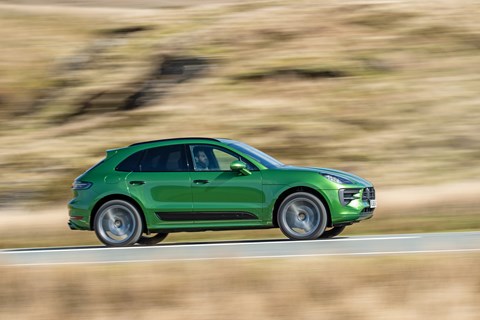
This is definitely a basic Porsche Macan. Don’t let the Instagram-influencer spec and £14k of options fool you. Four cylinders and two litres of petrol power, and a £46k point of entry, make it the least powerful, cheapest Macan you can buy. That’s nothing to be sniffed at – this remains an extremely good car, downsized engine or no.
With diesel Macans now discontinued for the facelifted five-year-old, it’s also the only choice if you want to maximise mpg and minimise CO2, though 25.7mpg and 185g/km is nothing to write home about.
Open the door and go to park your bottom in the Macan’s shapely seat and you practically fall into it, particularly after the stately-home Range Rover – in this context, it feels like a sports-car driving position. Drives like one, too. There’s a flow to the Porsche, even at a canter, with telepathic communication from the juicy and direct steering, a weighty thunk to the PDK paddles on every shift (there’s no manual gearbox) and a precision from the brake pedal that even the impressively-stoppered Audi Q3 can’t match. This Macan might wear 21-inch alloys (an inch bigger than the Evoque’s) but it strikes a superb balance between responsive, roll-free handling and the ability to deal with most (if not all) road lumps thanks to optional PASM adaptive dampers – a worthwhile £816 investment. Road noise is more intrusive than is the case in the bank-vault Evoque, and the Range Rover’s ride more isolating, but unless you live for motorways, the Macan’s set-up is the more appealing.
While you enjoy the Evoque for being impressively capable and entertaining given its size and high centre of gravity, you fall for the Macan because it so ruthlessly destroys any road you place before it; it’s simply a good car to drive full stop, no caveats. Stuttgart’s wizardry at making an SUV drive like a sports car continues to boggle the mind, five years after its now-best-selling model first hit the road. To say the chassis could handle more power is a wild understatement.
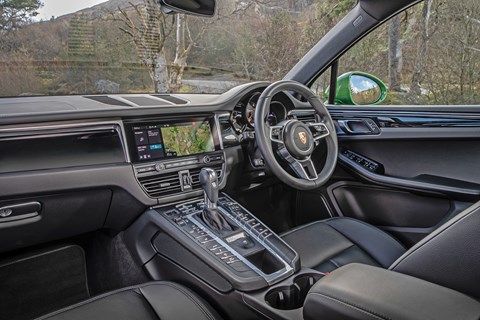
At 242bhp and 273lb ft the Porsche has more torque than both rivals. Pin it and the turbocharged petrol four feels as fast as the others – the more powerful but heavier Evoque and lighter but less powerful Q3 – but you do have to work more at the Porsche’s midrange, its small on-paper torque victory counting for nothing.
Pick-up from low revs is unenthusiastic at best, and the top end is completely breathless, so winding that lurid orange rev needle all the way clockwise is a fruitless endeavour, especially when the accompanying aural experience is so flat and whooshy. Of course, that just means you play with the satisfying PDK paddleshifters more to stay in the powerband, which is far from a bad thing. Plus, four cylinders means less weight over the nose than a six – this base Macan is 70kg lighter than an S.
The uncharismatic engine might be enough to persuade some to step up to the Macan S, which costs only £2.4k more but makes a gigantic leap into the distance with 349bhp and a more cultured V6 soundtrack. But even in this most basic mechanical spec, the Macan is still a driving experience to savour. There is 911 magic here, believe it or not.
The cockpit too bears the 911 comparison, even if it is a little gloomy in this black spec. Trademark cues include the central, analogue revcounter (and the rest of the dials for that matter), small three-spoke steering wheel, and the well-shaped and weighty PDK gear selector that feels tremendously satisfying to whump into drive or reverse, even if it does take away a bit of swift manoeuvrability when doing three-point turns or tight parallel parking.
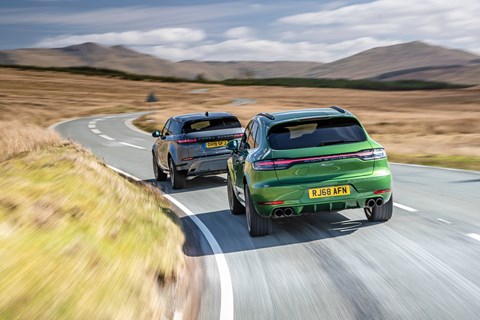
The widescreen infotainment is familiar too, shoehorned into the dashboards of every current Porsche bar the 718 twins. It certainly dominates the cockpit and has a clean design, though there are too many sub-menus to fathom for my liking. The slick touchscreen also clashes with physical buttons for Sport mode, damper settings and the like on a centre console that looks like a Pearly King or Queen’s jacket and is made from plastic that doesn’t feel entirely to Porsche’s usually high standards. You can’t knock the functionality, though.
Of course, unlike the 911 interior that the Macan lifts from, you get actual rear seats for full-size people. Legroom is on a par with the Evoque, and because this Macan is devoid of a glass roof, you can even wear an excessive hat to celebrate Porsche ownership. Spacious enough boot too. Prod the button hidden away on the rear wiper spindle (designed to deter thieves, although less so now I’ve pointed it out) and the light bar-clad tailgate lifts to reveal a flat and wide 500-litre space. Truly this is a real-life ready Porsche.
Audi Q3: let’s hope for better results in Q4

Audi’s small crossover offerings are like the different halves of your brain. While the Q2 is all mad colour combos and chunky styling, the Q3 looks like it’d be happy pondering anomalies on a spreadsheet in a dark office cubicle. It makes for a similarly stark contrast after climbing from the pizazz of the Evoque. The dashboard plastics have a quality feel, the fit and finish are excellent and there are flashes of flair, with an alcantara dashboard topper here and robot-arm door handles there, but this is not a space capable of seduction.
But let’s not forget that the Q3 is the least expensive car on test by a big margin. At £37,670 in standard S-line trim, it’s almost £9k below a basic Macan, the next most affordable SUV here. Even lavished with £10k of options, this Q3 is still £4k below our Evoque’s basic price. But the Q3’s interior does look like it’s from a regular family hatch, not a premium SUV, and that suspicion’s exacerbated by the cheap feel of key touchpoints including the gear selector and electric seat switches.
Perhaps Audi’s put all the cash into the tech, because it still knows how to do that properly. The double-screen layout of larger Audis is fiddly at best, attention-hogging at worst, so the Q3’s single-touchscreen layout is much more welcome, even if it isn’t as visually impressive. So big it’s like walking into someone’s (admittedly rather sober) living room, the Q3’s touchscreen controls easily the most user-friendly infotainment system on test, with a simple navigation layout, customisable tile-based menu system and no messing about with on-screen climate controls – it’s just manual air-con dials here, which are far easier to use while driving.
Virtual Cockpit – Audi’s now long-established digital instrument binnacle – adds extra high-tech polish, and you can spec Virtual Cockpit Plus for £250 with a very un-Audi instrument design straight out of a Lamborghini Reventón. Gadget fans might also be impressed by lane-departure warning being standard on every Q3, too, but I wish it wasn’t so frustratingly intrusive.
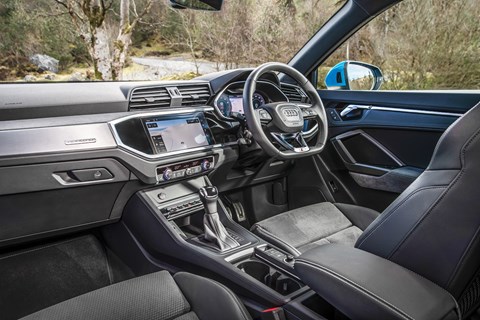
This top-spec 45 TFSI jumps to life with the bark of a Golf GTI and its on-paper figures back up the attitude. With 227bhp and 258lb ft, the 2.0-litre petrol engine is actually weaker than the Macan’s and the Evoque’s, but a kerbweight that’s more than 200kg lighter than both helps the underdog scoot from zero to 62mph in 6.7 seconds – even the Porsche is four tenths of a second off the Audi. That it was at least 8mpg better on test further highlights the virtuous circle put in place by that cleverly engineered lightweight aluminium.
If all this sounds highly exciting, sadly thrills have never been on the specials menu chéz Q3. Power delivery from the turbo four is without hiccup, torque lump or heady top-end: it’s just an unending surge and a swell of revs, until the dual-clutch ‘box swaps gears quicker than you can blink. That’s if you’re instigating shifts with the wheel-mounted paddleshifts; leave the Q3 in auto and give it heavy throttle prods and the gearbox feels like it’s reeling after a rather heavy Christmas dinner, even in Dynamic mode. The steering and the pedals are almost entirely mute too, though at least they’re precise, and the brakes have more bite than the Evoque’s.
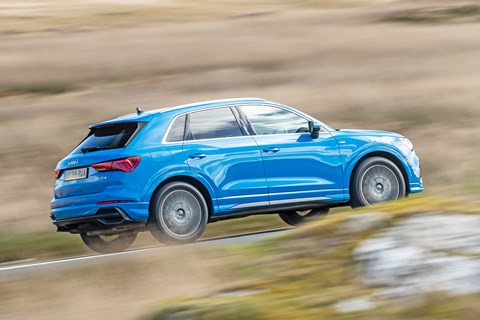
The Q3, does, however, impress with its refinement. It can’t quite match the Evoque’s floating-in-an-isolation-chamber zen, but the high-speed ride on our car’s 19-inch alloys paired with adaptive dampers makes for a welcome squidginess on potholed highways. Think twice before picking a bigger wheel size or not optioning Magnetic Ride on your S-line model. And buy a big cushion. The Q3 also plays an ace in terms of practicality. Its 530-litre boot is 30 litres up on the next-best Porsche, despite being 212mm shorter, and it has the most accessible load area too. Even with the BFG driving, there’s still plenty of space for adults in the rear, and it’s easy to slide the rear bench fore and aft to sacrifice some legroom in favour of boot space or vice versa.
This is where the Q3 really comes into its own. It’s designed to be a family ferry – more of a Boeing Dreamliner than the Gulfstream G6 Evoque or Eurofighter Typhoon Macan. It excels at comfortable cruising and even willingly coasts with the engine off, the whole brood aboard and a decent amount of luggage checked in to the capacious hold. But you’ll always remember being a passenger in a G6 or a Typhoon – can you say the same about a modern commercial airliner?
Final reckoning: which crossover goes the distance?
Three updated posh crossovers, three very different ways of appealing to broadly the same market. The Audi Q3 places third. It is far from a bad car, but there’s no question it’s the least engaging to drive. Even on some of the most beautiful and demanding roads in the UK, it sucks every particle of fun out of the A-to-B process, responding almost apathetically to driver inputs. It soon makes you feel the same way about the driving experience. But dynamic heroics are not the Audi’s key objective – it’s more focused on being the comfortable, spacious, stylish family do-it-all, and it arguably does the best job of the three if that’s your brief. That the Q3 offers such intuitive infotainment, costs so much less than rivals and turns in significantly better mpg are further reasons to buy.
But then the Evoque does a pretty solid job of the basics, too, with room for people in the back and a boot that’s still big enough for family life. It is no dynamic benchmark, but it’s far more fun to pedal than the Audi. The P250 is a punchy engine, and when you cool the speed it eases effortlessly into full-size Range Rover refinement.
The Evoque’s exterior design is more stylish than the Q3, and its cockpit has more theatre, with tantalising details including slick hidden-until-lit capacitive switches and the smart Touch Pro Duo touchscreens. There are also some pretty serious off-road smarts should the need arise.
But it’s not enough to topple the Macan. The Porsche is an SUV that doesn’t drive like an SUV, placing you low in the cockpit for an almost sports-car-like feel, and furthering the illusion with a thrilling drive to match – even if the four-cylinder engine lacks any kind of zing.
It’s less luxurious inside than the Evoque, but the quality is generally top-notch, and there are plenty of Porsche sports-car cues – steering wheel, instrument binnacle – to make having kids and carrying family kit not so painful after all. The Macan is just as spacious as the others, shrugs off long commutes thanks to its balanced ride, and looks just as smart as the Evoque too. It’s a great all-rounder.
Audi’s Q3 goes for the no-nonsense approach; the Range Rover is tremendously luxurious, desirable and fun to drive; but it’s Porsche’s Macan that does pose, practicality and performance like no other.
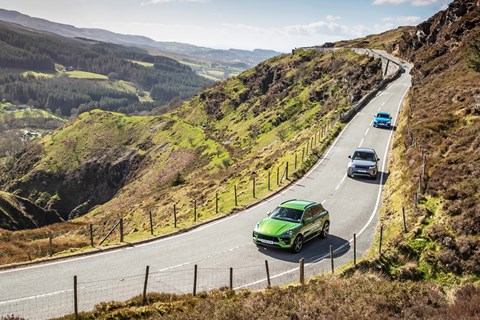
Evoque vs Macan vs Q3: verdict
First place: Porsche Macan
Witchcraft handling, a sports car’s interior and balanced practicality, but the engine has no character.
Second place: Range Rover Evoque
Not as dynamic as the Macan but lays on the luxury to compensate. Comfy, stylish, desirable.
Third place: Audi Q3
Quiet, refined and flexible for family life, but don’t come here looking for fun.
Check out our Best car lists right here